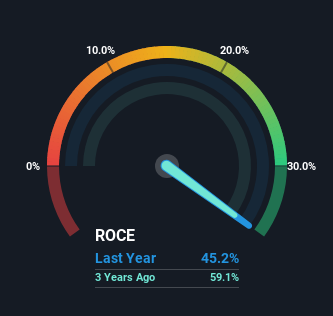
Finding a business that has the potential to grow substantially is not easy, but it is possible if we look at a few key financial metrics. Typically, we'll want to notice a trend of growing return on capital employed (ROCE) and alongside that, an expanding base of capital employed. Ultimately, this demonstrates that it's a business that is reinvesting profits at increasing rates of return. So while eWeLLLtd (TSE:5038) has a high ROCE right now, lets see what we can decipher from how returns are changing.
Our free stock report includes 1 warning sign investors should be aware of before investing in eWeLLLtd. Read for free now.What Is Return On Capital Employed (ROCE)?
Just to clarify if you're unsure, ROCE is a metric for evaluating how much pre-tax income (in percentage terms) a company earns on the capital invested in its business. The formula for this calculation on eWeLLLtd is:
Return on Capital Employed = Earnings Before Interest and Tax (EBIT) ÷ (Total Assets - Current Liabilities)
0.45 = JP¥1.1b ÷ (JP¥3.1b - JP¥559m) (Based on the trailing twelve months to December 2024).
Therefore, eWeLLLtd has an ROCE of 45%. In absolute terms that's a great return and it's even better than the Healthcare Services industry average of 17%.
View our latest analysis for eWeLLLtd

Above you can see how the current ROCE for eWeLLLtd compares to its prior returns on capital, but there's only so much you can tell from the past. If you'd like, you can check out the forecasts from the analysts covering eWeLLLtd for free.
What Can We Tell From eWeLLLtd's ROCE Trend?
On the surface, the trend of ROCE at eWeLLLtd doesn't inspire confidence. To be more specific, while the ROCE is still high, it's fallen from 59% where it was four years ago. Although, given both revenue and the amount of assets employed in the business have increased, it could suggest the company is investing in growth, and the extra capital has led to a short-term reduction in ROCE. And if the increased capital generates additional returns, the business, and thus shareholders, will benefit in the long run.
On a related note, eWeLLLtd has decreased its current liabilities to 18% of total assets. That could partly explain why the ROCE has dropped. Effectively this means their suppliers or short-term creditors are funding less of the business, which reduces some elements of risk. Some would claim this reduces the business' efficiency at generating ROCE since it is now funding more of the operations with its own money.
What We Can Learn From eWeLLLtd's ROCE
In summary, despite lower returns in the short term, we're encouraged to see that eWeLLLtd is reinvesting for growth and has higher sales as a result. And the stock has followed suit returning a meaningful 41% to shareholders over the last year. So while the underlying trends could already be accounted for by investors, we still think this stock is worth looking into further.
If you want to continue researching eWeLLLtd, you might be interested to know about the 1 warning sign that our analysis has discovered.
High returns are a key ingredient to strong performance, so check out our free list ofstocks earning high returns on equity with solid balance sheets.
New: Manage All Your Stock Portfolios in One Place
We've created the ultimate portfolio companion for stock investors, and it's free.
• Connect an unlimited number of Portfolios and see your total in one currency
• Be alerted to new Warning Signs or Risks via email or mobile
• Track the Fair Value of your stocks
Have feedback on this article? Concerned about the content? Get in touch with us directly. Alternatively, email editorial-team (at) simplywallst.com.
This article by Simply Wall St is general in nature. We provide commentary based on historical data and analyst forecasts only using an unbiased methodology and our articles are not intended to be financial advice. It does not constitute a recommendation to buy or sell any stock, and does not take account of your objectives, or your financial situation. We aim to bring you long-term focused analysis driven by fundamental data. Note that our analysis may not factor in the latest price-sensitive company announcements or qualitative material. Simply Wall St has no position in any stocks mentioned.
About TSE:5038
eWeLLLtd
Develops business support cloud services for visiting nursing stations in Japan.
Exceptional growth potential with outstanding track record.
Market Insights
Community Narratives



